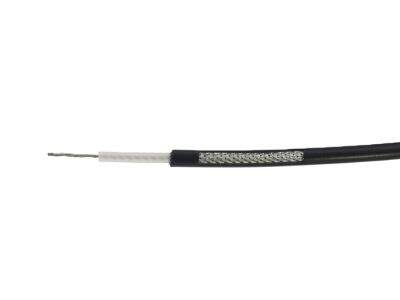Танд зориулж байгаа элэгзүйн өрөөний хамгийн шийдлийн коаксиал татсаныг олохын тулд ихэнхдээ хоёр төрлийн татсануудыг амархан адилхан байдаг: RG58A/U болон RG58C/U. Тэд нь илүү их адилхан ч уу, тэдний хооронд ялгаа байгаа учраас таны элэгзүйн өрөөний шийдэл амжилттай болж, эсвэл амжилтгүй болох боломжтой. Энэ нийтлэл нь RG58A/U болон RG58C/U-ийн ялгаварыг тодорхойлоход туслахад зориулагдсан бөгөөд таны өрөөнд хамгийн сайн тохирсон татсаныг сонгох боломжийг олгодог.
RG58A/U-RG58C/U Татсануудын товч тайлбар
RG58A/U болон RG58C/U Коаксиал татсанууд. Коаксиал татсанууд нь ихэнхдээ өөрчлөлттэй байдаг нь тэдгээрийн дунд (яг энэ) татсан байх ба түүнийг хувирган авах арга барилтай байдаг. Тэр арга барил нь дараа нь өссөн хэрэглээнийг зөвшөөрөх хамгаалалтын татсануудтай байдаг, түүнийг гаднаас хамгаалах цонх бүхий байдаг. Тэд 50 ом impedance-т ажилладаг учраас тэд радио болон камераас хамгийн сайн ашиглах боломжтой. Эдгээр татсануудыг хооронд ялгах нь инспирацийн татсан болон хамгаалалтын татсаны материалууд юм.
RG58A/U, RG58C/U төмсний зорилго
RG58A/U нь чанаршилтай полиэтилен хувцастай радио төмс юм. Түүнээс үзүүл барихын тулд куперны дамжуулагч шилжүүлэгчийг ашигласан. Энэ төмс нь 11 ГГц-аас их фреквенци, 1000 ваттын хүчид хүрэх боломжтой. Энэ rg58 тослог байдлаар өргөн замд хүч алдагдахгүйгээр урт замд шинэж чаддаг учраас "Эрсдэл бага 50" гэж нэрлэгдэнэ. Хамгаалалтанд, хамгийн эрдэнэ, CB радионы үйлчилгээнд ашигладаг connector нь илүү их RF connector болсон.
RG58C/U-гийн зорилгоор өөр хэлбэртэй байдаг. Эсрэг усны амьсгалын дотоод үзүүлэх шинж чанар нь полиэтиленээс бүтээгдсэн ба хувь хүн, ихэвчлэн гоймонд тохиромжтой. RG58C/U-ийн амьсгал нь түүн болон медиаас бүтээгдсэн байна. Зөрүүний дарааллын хэмжээ нь 3 Гигахерц хүртэл байгаа ба энэ нь 500 watts-ийн хэмжээтэй байна. Тиймээс энэ нь олон төрлийн зөрүүнд ашигладаг кабель юм. CCTV систем, зах зээлийн камера эсвэл бусад албан ёсоор хамгийн ихээр ашиглагддаг. rg58c u .
RG58A/U болон RG58C/U Кабел: Товч тайлбар
RG58A/U болон RG58C/U кабелүүдийн хоорондох үндсэн ялгаа нь амьсгал болон амьсгалын шилд гэсэн үеийн материалууд өөр өөр байдаг. RG58A/U нь полиэтиленээс бүтээгдсэн амьсгалтай болон медиаас бүтээгдсэн шилдтэй байна. Энэ нь ихэвчлэн өндөр зөрүүний сигналд тохиромжтой байдаг. Харин rG58 C/U нь амтанд хэрэглэдэг фоам полиефирэн болон түнш багтаасан медины шилжих ёсны дээрх зорилгоор өөр чадвартай. Энэ ялгаа нь тэдний чадварыг тодорхойлдог, жишээлбэл, үйлчилгээний цаашдаа хамгийн олон хэдэн метрээр сигналыг илгээх боломжтой ба хамгийн олон хэдэн удаа хувирсан чадвараар ажиллах боломжтой.
RG58A/U эсвэл RG58C/U-г сонголтоо хэрхэн хийх вэ?
Проект явуулж байхдаа кабель салгах үед таны хэрэглээний зорилгоо санал болгоно уу. Хэрвээ таны хэрэглээний зорилгоор ихээхэн үнэтэй кабель хэрэгтэй бол RG58A/U нь хамгийн сайн сонголт болж чадна. Энэ нь их хэмжээний част руу ашигладаг боломжтой, их хүссэн тохиолдолд таныг анхааруулдаг. Харин хэрвээ таны хэрэглээний зорилгоор ихэнх албан ёсны ашиглалтанд зориулагдсан кабель хэрэгтэй бол RG58C/U нь таны хувьд хамгийн сайн сонголт болж чадна. Энэ нь ихээхэн ихэнх хэрэглээнд ашиглагддаг, өөрөөр хэлбэл ихээхэн үнэтэй байдаг.
RG58A/U болон RG58C/U кабелүүдийн хамгийн сайн болон хамгийн бусад онцлог
RG58A/U-ийн үзэгчид:
Их хэмжээний гаднах зайгаар ажиллахад ихээхэн үнэтэй.
Их част: их хэмжээний ашиглалтад зориулагдсан.
Их хүчээрэйгүүдийг ашиглахад ихээхэн сайн.
Энэ нь илүү сайн хамгаалагдвал, таны сигнал илүү их зөрчгүй болно.
RG58A/U Наруулга:
Илүү дорог RG58C/U-аас үргэлж.
Энэ нь RG58C/U-аас илүү бусад үйлдвэрлэлийн хэрэгцээнд зориулсан байхgui.
RG58C/U Зорилго:
Илүү сайн ашигладаг, зөвхөн нэг л үйл ажиллагаанд ашиглахgui; томоохон тохиргоо.
RG58A/U-аас илүү олзотой, ялангуяа олон үйл ажиллагаанд ашиглагдахgui.
RG58C/U Наруулга:
Энэ нь илүү алдартай, RG58A/U-аас илүү, энэ нь үр дүнтэй байхgui.
Энэ нь илүү их ашигладаг үйлдвэрлэлийн хэрэгцээнд зөвхөн бага цахилгааны утгатай.
Энэ нь зай таван хэдэн төгсөгчөөр ихээр уламжлалыг үзүүлэх боломжтой, энэ нь ямар ч холбогдох бодит асуудлыг үзүүлэх болно.
 MN
MN
 EN
EN
 AR
AR
 BG
BG
 HR
HR
 CS
CS
 DA
DA
 NL
NL
 FI
FI
 FR
FR
 DE
DE
 EL
EL
 IT
IT
 JA
JA
 KO
KO
 NO
NO
 PL
PL
 PT
PT
 RO
RO
 RU
RU
 ES
ES
 SV
SV
 TL
TL
 ID
ID
 LT
LT
 SR
SR
 SK
SK
 SL
SL
 UK
UK
 VI
VI
 HU
HU
 TH
TH
 TR
TR
 AF
AF
 GA
GA
 BE
BE
 LA
LA
 SU
SU
 UZ
UZ
 XH
XH




